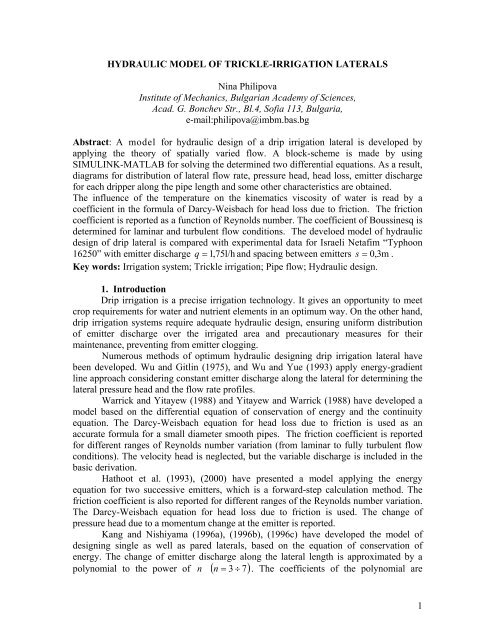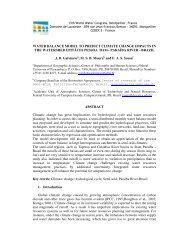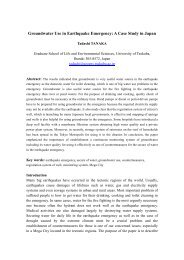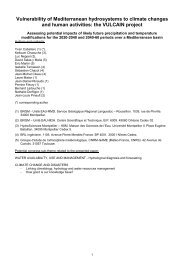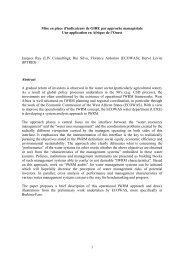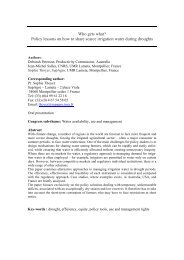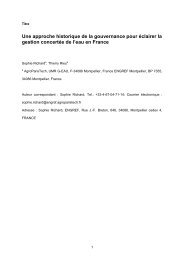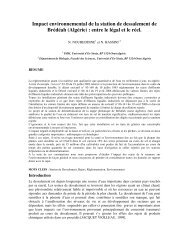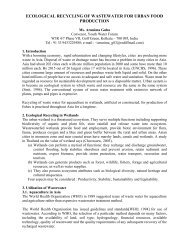HYDRAULIC MODEL OF TRICKLE-IRRIGATION LATERALS - IWRA
HYDRAULIC MODEL OF TRICKLE-IRRIGATION LATERALS - IWRA
HYDRAULIC MODEL OF TRICKLE-IRRIGATION LATERALS - IWRA
Create successful ePaper yourself
Turn your PDF publications into a flip-book with our unique Google optimized e-Paper software.
<strong>HYDRAULIC</strong> <strong>MODEL</strong> <strong>OF</strong> <strong>TRICKLE</strong>-<strong>IRRIGATION</strong> <strong>LATERALS</strong><br />
Nina Philipova<br />
Institute of Mechanics, Bulgarian Academy of Sciences,<br />
Acad. G. Bonchev Str., Bl.4, Sofia 113, Bulgaria,<br />
e-mail:philipova@imbm.bas.bg<br />
Abstract: A model for hydraulic design of a drip irrigation lateral is developed by<br />
applying the theory of spatially varied flow. A block-scheme is made by using<br />
SIMULINK-MATLAB for solving the determined two differential equations. As a result,<br />
diagrams for distribution of lateral flow rate, pressure head, head loss, emitter discharge<br />
for each dripper along the pipe length and some other characteristics are obtained.<br />
The influence of the temperature on the kinematics viscosity of water is read by a<br />
coefficient in the formula of Darcy-Weisbach for head loss due to friction. The friction<br />
coefficient is reported as a function of Reynolds number. The coefficient of Boussinesq is<br />
determined for laminar and turbulent flow conditions. The develoed model of hydraulic<br />
design of drip lateral is compared with experimental data for Israeli Netafim “Typhoon<br />
16250” with emitter discharge q = 1,75l/h<br />
and spacing between emitters s = 0,3m .<br />
Key words: Irrigation system; Trickle irrigation; Pipe flow; Hydraulic design.<br />
1. Introduction<br />
Drip irrigation is a precise irrigation technology. It gives an opportunity to meet<br />
crop requirements for water and nutrient elements in an optimum way. On the other hand,<br />
drip irrigation systems require adequate hydraulic design, ensuring uniform distribution<br />
of emitter discharge over the irrigated area and precautionary measures for their<br />
maintenance, preventing from emitter clogging.<br />
Numerous methods of optimum hydraulic designing drip irrigation lateral have<br />
been developed. Wu and Gitlin (1975), and Wu and Yue (1993) apply energy-gradient<br />
line approach considering constant emitter discharge along the lateral for determining the<br />
lateral pressure head and the flow rate profiles.<br />
Warrick and Yitayew (1988) and Yitayew and Warrick (1988) have developed a<br />
model based on the differential equation of conservation of energy and the continuity<br />
equation. The Darcy-Weisbach equation for head loss due to friction is used as an<br />
accurate formula for a small diameter smooth pipes. The friction coefficient is reported<br />
for different ranges of Reynolds number variation (from laminar to fully turbulent flow<br />
conditions). The velocity head is neglected, but the variable discharge is included in the<br />
basic derivation.<br />
Hathoot et al. (1993), (2000) have presented a model applying the energy<br />
equation for two successive emitters, which is a forward-step calculation method. The<br />
friction coefficient is also reported for different ranges of the Reynolds number variation.<br />
The Darcy-Weisbach equation for head loss due to friction is used. The change of<br />
pressure head due to a momentum change at the emitter is reported.<br />
Kang and Nishiyama (1996a), (1996b), (1996c) have developed the model of<br />
designing single as well as pared laterals, based on the equation of conservation of<br />
energy. The change of emitter discharge along the lateral length is approximated by a<br />
n = 3 ÷ 7 . The coefficients of the polynomial are<br />
polynomial to the power of n ( )<br />
1
determined using the least square method at a given inlet flow rate of lateral and at an<br />
inlet pressure head of lateral. The Darcy-Weisbach equation for head loss due to friction<br />
is used too. The friction coefficient is considered as a function of Reynolds number for<br />
different flow conditions (from laminar to fully turbulent).<br />
Kosturkov and Simeonov (1990), have developed a model of designing<br />
horizontal, non- deformable trickle lateral on the basis of the momentum approach. The<br />
longitudinal projection of discharged velocity is considered as a linear function of the<br />
averaged flow velocity. An analytical decision of the two differential equations obtained<br />
is proposed (the momentum equation and the conservation of mass equation) (Kosturkov,<br />
1990).<br />
Yildirim and Agiralioglu (2004) have performed a good comparative analysis of<br />
the developed hydraulic methods in design of microirrigation laterals.<br />
Von Bernurth (1990), Holzapfel et al. (1990), Bagarello et al. (1995) take into<br />
account the influence of temperature on the viscosity change in the hydraulic design of<br />
drip irrigation system. It is proved that when the water temperature changes from 15,5º C<br />
to 37,7º C (from 60º F to 100º F) the density decreases by less than 1% but viscosity<br />
decreases by about 40% (Munson, Young and Okishi, 1990). That is why the influence of<br />
temperature and Reynolds number will be taken into account when the change of water<br />
kinematic viscosity is considered.<br />
The objective of the work presented in this paper is a model derivation for<br />
hydraulic design of a drip lateral on the basis of theory of spatially varied flow and with<br />
application in the drip irrigation practice.<br />
2. Theoretical backgrounds of the developed model of trickle irrigation<br />
laterals<br />
The deduced model by Petrov (1951) is an one-dimensional hydraulic equation,<br />
based on the momentum approach. It describes a steady spatially varied flow with<br />
dz<br />
averaged velocities, and inconstant flow area at slope with a gradient . The head loss<br />
dx<br />
due to friction is calculated by means of the formula of Darsy-Weisbach that is accurate<br />
for a small diameter smooth pipes. The pipe is considered as non-deformable one. In the<br />
case of lateral outflow along the pipe with a constant diameter, the equation is as follows:<br />
2<br />
1 dp dV dz V 1 ( V −θ<br />
) V dQ<br />
+ α V + + λ + α<br />
= 0 , (1)<br />
ρ dx dx dx 2 D Q dx<br />
where: V is the averaged flow velocity throughout the cross-section; p is the pressure<br />
assumed to be constant throughout the cross-section; α is a coefficient of Boussinesq; θ<br />
is the longitudinal projection of discharged velocity , θ = δV<br />
; δ is a coefficient of<br />
proportionality between the longitudinal projection of discharged velocity and the<br />
3<br />
averaged flow velocity throughout the cross-section; Q is the flow rate in m / s ; γ is the<br />
specific weight of water, γ = ρ g (for incompressible fluid); g - gravity acceleration.<br />
The last term of the equation (1) reports discharging the flow along the lateral<br />
length according to the theory of Meshterski (Petrov, 1951) and the previous term<br />
represents the head loss due to the friction per unit length.<br />
Taking into account the outflow at a distance between emitters s , the equation of<br />
the conservation of mass is as follows:<br />
2
dQ<br />
dx<br />
q<br />
k<br />
h<br />
s<br />
k 1<br />
= − = − , (2)<br />
where: q is the discharged flow per unit length in l / h (emitter outflow per unit length);<br />
k<br />
kh 1<br />
is the exponential relationship of the dripper; k , k1<br />
are constants depending on the<br />
type of the dripper and its flow regime; h is the pressure head; s is the distance between<br />
drippers.<br />
3<br />
Expressing the discharged flow per unit length q in m / s , the equation (2) obtains the<br />
following form:<br />
dQ<br />
k k<br />
= −q<br />
= −F<br />
1<br />
Q<br />
h , (3)<br />
dx<br />
s<br />
where: is the coefficient converting from liters per hour to cubic meters per second,<br />
F Q<br />
F Q<br />
= 2,7777x 10<br />
-7<br />
.<br />
3. Formulas used for deriving model equation<br />
The following basic equations are used:<br />
3. The normal projection of friction forces for a lightly changed flow are neglected and<br />
the pressure is constant throughout the cross-section. The pressure is as follows:<br />
p = ρgh . (4)<br />
2) The formulae for the ground slope:<br />
dz<br />
sin ψ = − , (6)<br />
dx<br />
where: ψ is the lateral slope angle;<br />
3) The Darsy-Weisbach formulae for head loss which is due to friction per unit length<br />
can be expressed as:<br />
∆h<br />
f<br />
n m n<br />
= K<br />
loc<br />
K<br />
0FQ<br />
D Q , (7)<br />
l<br />
∆h f<br />
where: is the head loss due to the friction per unit length; n is the exponent of the<br />
l<br />
flow rate; m is the exponent of the pipe diameter; D is the pipe diameter, K<br />
loc<br />
is the<br />
Benami and Offen coefficient (Benami and Offen, 1984) of the local head loss of<br />
emitters, read as a function of the dripper type (online or inline), the distance between the<br />
drippers and the pipe diameter; K 0<br />
is the coefficient reading the kinematic viscosity<br />
change as a function of temperature and Reynolds number.<br />
4. The derived equation of the model<br />
The following equation is derived on the basis of aforementioned equations (4) –<br />
(7), the momentum equation of Petrov (1), and the equation of conservation of mass (3)<br />
for steady flow movement with lateral outflow along the lateral length, where the crosssection<br />
of the pipeline is assumed to be constant:<br />
3
dh 1,6α<br />
Q k1 n m n<br />
g − g sinψ − kh ( 2 − δ ) + K<br />
0<br />
= 0,<br />
4<br />
loc<br />
K FQ<br />
D Q<br />
(8)<br />
dx<br />
D<br />
The other form of the derived model equation is the following:<br />
dh 1,6α<br />
Q<br />
⎛ ∆h<br />
k<br />
f ∆h<br />
⎞<br />
1<br />
loc<br />
g − g sinψ − [ kh (2 − δ ] +<br />
= 0<br />
4 ⎜ +<br />
⎟g<br />
(9)<br />
dx<br />
D s<br />
⎝ l l ⎠<br />
where: ∆h loc<br />
are the local head loss due to the emitters. Using this equation the formula<br />
of Provenzano and Pumo (2003) can be used for estimating local head loss of “in-line”<br />
drippers. Comperative analysis between the two approaches of local head loss estimating<br />
for “in-line” emitters is performed in Philipova (2007a). The formula of Y. Reddy (2003)<br />
could be used for estimating local head losses “on-line” emitters. Comperative analysis<br />
between the two approaches of local head loss estimating for “in-line” emitters is<br />
performed in Philipova (2007b)<br />
Boundary conditions of the model are the following:<br />
x = 0 Q = Q = Nq h = h ,<br />
0<br />
0<br />
dQ<br />
x = l = −q k<br />
dx<br />
where: Q is the inlet flow rate of the lateral; N is the number of emitters; q is the<br />
0<br />
nominal emitter discharge; h0<br />
is the inlet pressure head; l is the length of the lateral,<br />
is the last emitter discharge of the dripline<br />
5. Head loss estimation due to friction<br />
The head loss due to friction is a function of the Reynolds number (Warrick and<br />
Yitayew, 1988, Hathoot et al.,1993, Kang and Nishiyama, 1996a).<br />
1) The friction coefficient λ for laminar flow Re ≤ 2000 , is defined below:<br />
64<br />
λ = ,<br />
Re<br />
∆h<br />
−4<br />
−4<br />
= 40,745ν Q D = K<br />
0<br />
Q D ,<br />
l<br />
(10)<br />
K = 40,745ν 0 (10’)<br />
where:ν is the kinematic viscosity of water.<br />
n = 1;<br />
m = −4 . (10’’)<br />
5<br />
2) The friction coefficient λ for turbulent flow in a smooth pipe 2000 < Re ≤ 10 ,<br />
according to the Blasius equation is as follows<br />
b<br />
λ = a Re ; a = 0,316; b = −0,25;<br />
∆h<br />
0,25 −4,75<br />
1,75<br />
−4,75<br />
1,75<br />
= 0,2413ν<br />
D Q = K<br />
0D<br />
Q ,<br />
l<br />
(11)<br />
0,25<br />
K<br />
0<br />
= 0,<br />
2413ν<br />
, (11’)<br />
n = 1,75;<br />
m = −4,75<br />
. (11’’)<br />
3) Watters and Keller (1978) derived the following formula for the friction coefficient<br />
5<br />
7<br />
λ for fully turbulent flow 10 < Re < 10 ,<br />
qk<br />
4
0,172<br />
λ = 0,13Re<br />
− ,<br />
∆h<br />
0,172 1,828 −4,828<br />
= 0,9977ν Q D ,<br />
l<br />
(12)<br />
0,172<br />
K<br />
0<br />
= 0,<br />
9977ν<br />
, (12’)<br />
n = 1,828;<br />
m = −4,828<br />
. (12’’)<br />
The coefficient K<br />
0<br />
is calculated on the basis of equations (10’), (11’), (12’) and<br />
data from kinematic viscosity dependence on temperature are taken from Lo’tziyanski<br />
(1987). The values of coefficient K = f (Re, ) are cited in Philipova (2005).<br />
0<br />
x<br />
6. Program in SIMULINK –MATLAB<br />
A block-scheme is made (shown in Fig. 1-Fig. 4) by using program SIMULINK –<br />
MATLAB on the basis of the equations (8), (3) and the formulae for the head loss per<br />
unit length (10), (11), (12).<br />
The Reynolds number Re is calculated for every step equal to the distance<br />
between drippers. The values of n,<br />
m are assumed in correspondence with the values<br />
(10’’), (11’’), (12’’).<br />
7. Coefficients estimation<br />
The Boussinesq coefficient α (momentum coefficient) for laminar and turbulent<br />
flow is defined as follows:<br />
1) For laminar flow in cylindrical pipe (May, 2005):<br />
R<br />
1 2 1 2<br />
α = v dA v ( 2π r)dr<br />
2 2<br />
AV<br />
∫ =<br />
AV<br />
∫<br />
A<br />
0<br />
where: A is the cross-sectional area; V is the averaged velocity; v is the local flow<br />
velocity; R is the pipe radius; r is the radius from the pipe centerline.<br />
The velocity distribution for laminar viscous flow in a cylindrical pipe is in<br />
accordance with a parabolic low:<br />
2<br />
⎡ ⎛ r ⎞ ⎤<br />
v = vmax ⎢1<br />
− ⎜ ⎟ ⎥<br />
(13)<br />
⎢⎣<br />
⎝ R ⎠ ⎥⎦<br />
where: vmax<br />
is the maximum velocity and V v max<br />
= 0, 5 .<br />
The value obtained for Boussinesq coefficient for laminar flow conditions<br />
isα<br />
= 1, 33<br />
2) The Boussinesq coefficient α for turbulent flow is in the interval of α = 1,01−1,<br />
10<br />
(Kosturkov, 2001, Ghidaoui, 2005).<br />
The coefficient of proportionality between the longitudinal projection of the<br />
discharged velocity and the averaged flow velocity throughout the cross-section - δ is in<br />
the interval δ = 0,1<br />
− 0, 9 . The values of coefficients α and δ are varied in the<br />
aforementioned intervals with steps 0 , 01 and 0, 1, respectively. The obtained data from<br />
the model for q are compared with the experimental data for q of the NETAFIM<br />
“Typhoon 16250” dripline. A program in FORTRAN is made for calculating:<br />
5
F<br />
SUM<br />
=<br />
N<br />
∑[ qTEOR<br />
− qEXP<br />
]<br />
j=<br />
1<br />
where: N is the number of emitters along lateral;<br />
2<br />
q TEOR<br />
(14)<br />
is the data for emitter discharge<br />
obtained by the model, and q EXP<br />
is the experimental data for the flow rate and then the<br />
minimum of the function F SUM<br />
have to be searched. The optimum values for the<br />
obtained α and δ , as a result, areα = 1, 10 , δ = 0, 1, respectively. The minimal value of<br />
δ is due to the small dimensions of the dripper and the sensitive decrease of the flow<br />
velocity just next to the dripline wall.<br />
Subsystem2<br />
1<br />
In<br />
O ut1 O ut2 O ut3 O ut4<br />
In1Out1<br />
In2Out2<br />
In3Out3<br />
In4Out4<br />
Subsystem<br />
In1<br />
Out1<br />
In2<br />
In3<br />
In4<br />
Out2<br />
I 5<br />
Fig.1. .Block-scheme of the model by program SIMULINK –MATLAB<br />
To File<br />
9.81<br />
g<br />
1<br />
1/uIn1<br />
1/g<br />
Gain<br />
Prod<br />
Pr1<br />
10<br />
h0<br />
1<br />
s x o<br />
h<br />
Pr13<br />
h12.ma<br />
|u|<br />
Abs<br />
Prt1<br />
Scope1<br />
u v<br />
0.48<br />
k1<br />
-1<br />
3 Out3<br />
3599971<br />
1/so<br />
1/u<br />
so<br />
0.3<br />
Fq2<br />
2.7778e-7<br />
h^k1<br />
k<br />
0.579<br />
3599971<br />
Fq3<br />
Qi2<br />
1.1e-4<br />
Qo<br />
Pr3<br />
Fq1<br />
Q55.ma<br />
To File1<br />
1<br />
s x o<br />
Q<br />
4 Out4<br />
Pr2<br />
1<br />
Out1<br />
Q^n<br />
u v<br />
3<br />
2 In2 In3<br />
4<br />
Prt2<br />
In4<br />
Qi1<br />
Prt3<br />
2<br />
Out2<br />
Fig. 2. Block-scheme for solving Equation (3) (Subsystem in Fig.1)<br />
6
2 In2<br />
Prt9<br />
Sum4<br />
2<br />
Out2<br />
Sum2<br />
Pr12<br />
Const<br />
-C-<br />
2<br />
D<br />
Delta<br />
0.1<br />
Pr11<br />
D^m<br />
u v<br />
1 In1<br />
1/u^4<br />
1/D^4<br />
Pr10<br />
1<br />
Out1<br />
Sum<br />
Const1<br />
Prt7<br />
1.62<br />
4<br />
5<br />
In4<br />
In5<br />
Gain1<br />
-1<br />
head loss<br />
Pr6<br />
Prt5<br />
Sum1<br />
si n Psi<br />
0.01<br />
3<br />
In3<br />
Kloc<br />
1.7<br />
g1<br />
9.81<br />
1<br />
1<br />
Fig.3. Block-scheme for solving Equation (7) (Subsystem1 in Fig.1)<br />
1<br />
In1<br />
f(u)<br />
Re<br />
RE<br />
2000<br />
2000<br />
1e5<br />
2<br />
1e7<br />
3<br />
5<br />
-2 5<br />
7<br />
for 2000 < Re ≤ 10 , K<br />
0<br />
= 9,2794x10<br />
for 10 < Re ≤ 10 . The coefficient of Boussinesq<br />
for laminar flow is α = 1,33 and for turbulent flow is α = 1, 10 . The coefficient of<br />
proportionality between the longitudinal projection of discharged velocity and the<br />
averaged flow velocity throughout the cross-section is δ = 0, 1.<br />
The first boundary condition of the model for the given example is:<br />
x = 0 Q = Q0<br />
= Nq = 407,75l/h h = h0<br />
= 1bar<br />
The second boundary condition is calculated by the program.<br />
The results calculated are drawn in diagrams: pressure head h = f (x) along the<br />
lateral length is shown in Fig. 5; dripline flow rate Q = f ( x)<br />
in Fig. 6; emitter<br />
discharge q in Fig.7 ; Re = f ( x)<br />
in Fig. 8; n = f (Re, x)<br />
in Fig. 9; m = f (Re, x) in<br />
Fig. 10; K = (Re, x) in Fig. 11; coefficient of Boussinesq α in Fig. 12, respectively.<br />
0<br />
f<br />
8. Results from the program<br />
Dripline Flow Rate Q(l/h)<br />
400<br />
350<br />
300<br />
250<br />
200<br />
150<br />
100<br />
50<br />
0<br />
0 10 20 30 40 50 60 70<br />
Lateral Length l(m)<br />
Fig.6. Distribution of pressure head<br />
h along the lateral length l<br />
Pressure Head h(m)<br />
10<br />
9.9<br />
9.8<br />
9.7<br />
9.6<br />
9.5<br />
9.4<br />
9.3<br />
9.2<br />
9.1<br />
9<br />
0 10 20 30 40 50 60 70<br />
Lateral Length l(m)<br />
Fig.7. Distribution of drip line flow rate<br />
along the lateral length l<br />
1.76<br />
14000<br />
Emitter Discharge q(l/h)<br />
1.74<br />
1.72<br />
1.7<br />
1.68<br />
Reynolds Number Re<br />
12000<br />
10000<br />
8000<br />
6000<br />
4000<br />
2000<br />
1.66<br />
0 10 20 30 40 50 60 70<br />
Lateral Length l(m)<br />
0<br />
0 10 20 30 40 50 60 70<br />
Lateral Length l(m)<br />
Fig.8. Distribution of emitter discharge<br />
along the lateral length l<br />
Fig.9. Distribution of Reynolds<br />
number along the lateral length<br />
8
Total Head Loss between Drippers (m)<br />
0.02<br />
0.018<br />
0.016<br />
0.014<br />
0.012<br />
0.01<br />
0.008<br />
0.006<br />
0.004<br />
0.002<br />
0<br />
0 10 20 30 40 50 60 70<br />
Lateral Length l(m)<br />
Fig.10. Total head loss between drippers<br />
along the lateral length l<br />
Exponent n<br />
1.8<br />
1.7<br />
1.6<br />
1. 5<br />
1.4<br />
1.3<br />
1.2<br />
1. 1<br />
1<br />
0 10 20 30 40 50 60 70<br />
Lateral Length l(m)<br />
Fig.11. Distribution of exponent n<br />
along the lateral length l<br />
Exponent m<br />
-3.9<br />
-4<br />
-4.1<br />
-4.2<br />
-4.3<br />
-4.4<br />
-4.5<br />
-4.6<br />
-4.7<br />
-4.8<br />
-4.9<br />
0 10 20 30 40 50 60 70<br />
Lateral Length l(m)<br />
Fig.12. Distribution of exponent m<br />
along the lateral length<br />
Coefficient Ko<br />
7<br />
6<br />
5<br />
4<br />
3<br />
2<br />
1<br />
0<br />
0 10 20 30 40 50 60 70<br />
8 x Lateral Length l(m)<br />
Fig.13.Distribution of coefficient<br />
K 0<br />
along the lateral length<br />
Boussinesq Coefficient<br />
1.35<br />
1.3<br />
1.25<br />
1.2<br />
1.15<br />
1.1<br />
0 10 20 30 40 50 60 70<br />
Lateral Length l(m)<br />
Emitter Discharge q [l/h]<br />
2,0<br />
1,9<br />
1,8<br />
1,7<br />
1,6<br />
1,5<br />
1,4<br />
1,3<br />
1,2<br />
1,1<br />
1,0<br />
0,9<br />
0,8<br />
0 10 20 30 40 50 60 70<br />
Lateral length l [m]<br />
Qteor<br />
Qexp<br />
Fig.14. Distribution of Boussinesq coefficient<br />
along the lateral length.<br />
Fig.15. Correlation between the model data and the<br />
experimental data.<br />
6. Calibration of the model<br />
Calibration of the model is shown in Fig.13. The comparison between the model<br />
data and the experimental data gives a good agreement. The value of correlation<br />
coefficient is 0,7.<br />
9
7. Analysis of the obtained results.<br />
The deviation of hydraulic head along the lateral length is in the limits of 9%,<br />
h0<br />
− hmin<br />
calculated according to the formula , where h 0<br />
is the hydraulic head at the<br />
h<br />
0<br />
lateral beginning, hmin<br />
is the minimum hydraulic head for the whole lateral length.<br />
The deviation of emitters discharge is in the limits of 5%, calculated according to<br />
q0<br />
− qmin<br />
the formula , where q 0<br />
is the emitter discharge at the lateral beginning, and<br />
q<br />
0<br />
q min<br />
is the minimum emitter discharge for the whole lateral length.<br />
The total head loss for l = 10m<br />
are 0,015m<br />
, and for l = 50m<br />
are 0 ,002m . The<br />
diagrams of exponents n, m , the one of coefficient K<br />
0<br />
, reading temperature influence<br />
on the kinematic viscosity and the coefficient of Boussinesq report that flow regime turns<br />
from turbulent to laminar at l = 60m .<br />
The “potential” emission uniformity of the drippers “Typhoon 16250”, calculated<br />
for the model data with local head loss reading by means of the Benami and Offen<br />
coefficient is calculated according to the formula (Keller и Karmeli (1974)):<br />
⎛ C ⎞<br />
V<br />
qmin<br />
EU = 100⎜1,0<br />
−1,27<br />
⎟<br />
(3.5.1.1)<br />
⎜ N ⎟ q<br />
p a<br />
⎝<br />
⎠<br />
where: EU is the emission uniformity, %; C is the coefficient of the manufacturer<br />
variability; N is the drippers number per plant; q is the minimum emitter discharge<br />
p<br />
along the lateral length; is the average emitter discharge along the lateral length .<br />
q a<br />
The “potential” emission uniformity for C<br />
V<br />
= 3%<br />
, N<br />
p<br />
= 8 , q = 1,665<br />
min<br />
l / h ,<br />
q a<br />
= 1,68261 is EU teor<br />
= 97,6%<br />
. The “real” emission uniformity for the experimental<br />
data q = 1, min<br />
55 , q a<br />
= 1,7239 is EU exp<br />
= 89%<br />
. The “real” emission uniformity is always<br />
less than “ the potential” emission uniformity .<br />
Burt и Styles (1994) point out, that the “potential” emission uniformity varies<br />
about 90%, and the “real” emission uniformity for California is about 70%.<br />
V<br />
min<br />
8. Conclusions<br />
A model for hydraulic design of a drip lateral on the basis of theory of spatially<br />
varied flow is derived in this paper<br />
The developed model and the program in SIMULINK-MATLAB give an<br />
opportunity for more accurate hydraulic design of trickle laterals. The model is<br />
theoretically based and the program is open for substituting with different lateral<br />
parameters. It is estimated in this paper that the deviation of hydraulic head along the<br />
lateral length is in the limits of 9%, that is within the limits of the allowable pressure and<br />
discharge variations. It was established in this paper that the deviation of emitters<br />
discharge is in the limits of 5%. For inline emitters it could be recommended δ = 0, 1. For<br />
online emitters averaged values for δ = 0, 5 and α = 1, 05 could be assumedm for<br />
10
turbulent flow conditions, because of the very little effect on the calculated F SUM<br />
.<br />
α = 1,33 for laminar flow. The good agreement between the model data and the<br />
experimental data prove the suitability of the model in the drip irrigation practice.<br />
Acknowledgments<br />
The auther would like to thank to all lecturers from CINADKO Course “Modern<br />
Irrigation Systems and Extension” (Israel,1998), especially to Anat Levingart, for the<br />
consultations about the model to Prof. I. Ivanov and for the assistance to Assoc. Prof. G.<br />
Welkovski, both from the Institute of Water Problems (Bulgarian Academy of Science).<br />
The presentation of this work on 13 th World Water Congress is supported by the<br />
Project NoBG051PO001/07/3.3-02/55.<br />
REFERENCES<br />
1. Bagarello, V., V. Ferro , G. Provenzano. Experimental study on flowresistance<br />
law for small diameter plastic pipes. Journal of Irrigation and Drainage<br />
Engineering , 121(1995), No5, 313-316.<br />
2. Benami, A., A. Offen. Irrigation engineering, 1 st Ed., IESP, Haifa, 1984.<br />
3. Burt, Ch., S. Styles, Drip and Microirrigation for Trees, Vines, and Row Crops,<br />
California Polytechnic State University, San Luis Obispo, California, 1994.<br />
4. Ghidaoui, M. Fundamental laws of hydraulics for a control volume<br />
(steady flow). (2005), http://teaching.ust.hk/~civil/Lecture/Chapter2.pdf<br />
5. Hathoot, H., A. Al-Amoud, F. Mohammad. Analysis and design of<br />
trickle-irrigated laterals. Journal of Irrigation and Drainage Engineering,<br />
119(1993), No5, 756-767.<br />
6. Hathoot, H., A. Al-Amoud, A. Al-Mesned. Design of trickle irrigation<br />
lateral as considering emitter losses. ICID J., 49(2000), No 2, 1-14.<br />
7. Holzapfel, E., M. Marino, A.Valenzuela. Drip irrigation non-linear<br />
optimization model. Journal of Irrigation and Drainage Engineering, 116 (1990),<br />
No4, 479-496.<br />
11
8. Kang, Y., S. Nishiyama. Analysis and design of microirrigation laterals. Trans.<br />
ASAE, 38 (1996), No5, 1377-1384.<br />
9. Kang, Y., S. Nishiyama. Analysis of microirrigation systems using a lateral<br />
discharge equation. Trans. ASAE, 39 (1996), No 3, 921-929.<br />
10. Kang, Y., S. Nishiyama. A simplified method for design of microirrigation<br />
laterals. Trans. ASAE, 39 (1996), No5, 1681-1687.<br />
11. Keller, J., D. Karmeli, Trickle Irrigation Design Parameters, Trans ASAE, 17 (1974),<br />
No 4, 678-683.<br />
12. Kosturkov, J. Method for hydraulic design of microirrigation system. Proc., 14 th<br />
ICID Congress, (1990), Rio de Janeiro, 37-49.<br />
13. Kosturkov, J., G. Simeonov. Identification of the parameters of pressurized<br />
delivery pipe model. Techn. Thought, 27(1990), No 2,51-56, (in Bulgarian).<br />
14. Kosturkov, J. “Examination of pressure flows with variable volume quantity along<br />
their length, PhD Thesis, Sofia, 2001,(in Bulgarian).<br />
15. Lo’tzyanski, L.. Fluid and gas mechanics, Nauka, Moscow, 1987, (in Russian).<br />
16. Mays, L. Flow process and hydrostatic forces. (Nov. 20, 2005).<br />
http://users.rowan.edu/~orlins/wre/Chap3.pdf<br />
17. Munson, B., D. Young, T. Okiishi. Fundamentals of fluid mechanics. John Wiley<br />
& Sons, New York – Chichester - Brisbane-Toronto – Singapore, 1990.<br />
18. Netafim, Drip Irrigation Products (Israel). (2004)<br />
http://www.netafim.com/Irrigation_Products/Drip_Irrigation/Thin_Wall/Typhoon.ht<br />
ml<br />
12
19. Petrov, G. Movement of spatially varied flow, State Publisher of Construction<br />
Literature, Moscow – Leningrad, 1951, (in Russian).<br />
20. Philipova, N. Modeling drip lateral flow on the base of the theory of<br />
spatially varied flow. Journal of Theoretical and Applied Mechanics, 35<br />
(2005), No 4, 21-32.<br />
21. Philipova N., Lateral Design Model of In-line Drippers Based on the Theory of<br />
Spatially Varied Flow, Jubilee conference, UACG, Sofia 17-18 May 2007, 41-56<br />
22. Philipova, N., Lateral Design Model of On-line Drippers “KP 4,6” Based on the<br />
Theory of Spatially Varied Flow, Jubilee conference, UACG, Sofia 17-18 May 2007,<br />
57-71.<br />
23. Provenzano, G., D. Pumo, Assessing a Local Losses Evaluation Procedure in Drip<br />
Integrated Laterals Design,<br />
http://afeid.montpellier.cemagref.fr/Mpl2003/AtelierTechno/AtelierTechno/Papier%2<br />
0Entier/N%C2%B062%20-%20ITALIE_BM.pdf<br />
24. Reddy ,Y., Evaluation of On-line Trickle Irrigation Emitter Barb Losses,<br />
http://www.ieindia.org/publish/ag/1203/dec03ag3.pdf<br />
25. von Bernurth, R. D. Simple and accurate friction loss equation for plastic pipe.<br />
Journal of Irrigation and Drainage Engineering,116(1990), No 2, 294-298.<br />
26. Warrick, A., M. Yitayew. Trickle lateral hydraulics. I: Analytical solution. Journal of<br />
Irrigation and Drainage Engineering, 114(1988), No 2, 281-288.<br />
27. Wu, I.., H. Gitlin. Energy gradient line for drip irrigation laterals. Journal of<br />
Irrigation and Drainage Engineering,101 (1975), No 4, 323-326.<br />
13
28. Wu, I. R. Yue. Drip lateral design using energy gradient line approach. Trans. ASAE,<br />
36(1993), No 2, 389-394.<br />
29. Yildirim, G., N. Agiralioglu, Comperative analysis of hydraulic calculation methods<br />
in design of microirrigation laterals. Journal of Irrigation and Drainage Engineering,<br />
130 (2004), No3, 201-217.<br />
30. Yitayew, M., A. Warrick. Trickle lateral hydraulics. II: Design and examples.<br />
Journal of Irrigation and Drainage Engineering, 114(1988), No 2, 289-300.<br />
14


